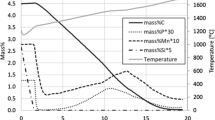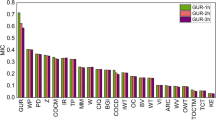Abstract
Liquefied petroleum (LP) gas is used as one of the fuel systems for glass production furnaces. This research was conducted to develop an intelligent online measurement system for monitoring and control of LP gas so as to achieve green and efficient manufacturing. LP gas is mixed with air at a desired ratio in order to get a proper specific gravity for glass production. Counterpropagation neural networks (CPNs), which are based on competitive learning, were used in this work. Three inputs, air inlet pressure, air/mixed gas differential pressure, and propane/mixed gas differential pressure, were selected for online measurements of specific gravity for monitoring and control of a glass production furnace. Using a 3 × 12 × 1 CPN yields exceedingly successful results for online measurements of specific gravity. An average error of 1.68 %, a minimum error of 0.08 %, and a maximum error of 4.43 % were achieved for online measurements. Control actions can then be taken to achieve much higher energy efficiency which is very important for glass production for green and efficient manufacturing.
Similar content being viewed by others
References
Abu-Zahra NH, Karimi S (2002) On-line monitoring of PVC foam density using ultrasound waves and artificial neural networks. Int J Adv Manuf Technol 19:618–622
Glass Manufacturing Industry Council (GMIC) (2000) Workshop Proceedings: Advances in Combustion Technologies for Glass Processing. Pittsburgh, PA
Makarov RI, Suvorov E (2010) Increasing the quality of tempered glass on an operating process line. Glas Ceram 67(5):18–21
Liu TI, Kumagai A, Lyons C (2006) On-line measurements for monitoring and diagnosis of glass production furnace. J CSME 27(5):587–592
Shahsbi HM, Ratnam MM (2009) In-cycle monitoring of tool nose wear and surface roughness of turned parts using machine vision. Int J Adv Manuf Technol 40:1148–1157
Sharmr VS, Shama SK, Shama AK (2008) Cutting tool wear estimation for turning. J Intell Manuf 19:99–108
Dornfeld DA (2014) Moving toward sustainable and green manufacturing. Int J Precis Eng Manuf-Green Technol 1(1):63–66
Ahn SH (2014) An evaluation of green manufacturing technologies based on research databases. Int J Precis Eng Manuf-Green Technol 1(1):5–9
The trade association for the LP Gas industry in the UK (2014) Targeting Carbon Reduction in Off Grid Britain. http://www.uklpg.org/exceptional-energy/targeting-carbon-reduction-in-off-grid-britain/
Baumann HD (2008) Control valve primer: a user’s guide, 4th edition, the instrumentation, systems, and automation society. North Carolina, USA
Co C (2013) Flow of fluids through valves, fittings, and pipe. Crane Valve Group, Stamford
Fisher Controls International, Emerson Process Management (2005) Control Valve Handbook, 4th edn. Fisher Controls International, Marshalltown
Nesbitt B (2007) Handbook of valves and actuators. Butterworth-Heinemann, Oxford
Prasad J, Jayaswal MN, Priye V (2011) Instrumentation and Process Control. International Publishing House, I K
Skousen PL (2011) Valve Handbook, 3rd edn. McGraw-Hall, New York
Baraldi P, Compare M, Sauco S, Zio E (2013) Ensemble neural network-based particle filtering for prognostics. Mech Syst Signal Process 41(1–2):288–300
Liu TI, Kumagai A, Wang YC et al (2010) On-line monitoring of boring tools for control of boring operations. Robot Comput Integr Manuf 26:230–239
Liu TI, Lee J, Singh P, Liu G (2014) Real-time recognition of ball bearing states for the enhancement of precision, quality, efficiency, safety, and automation of manufacturing. Int J Adv Manuf Technol 71(5):809–816
Liu TI, Song SD, Liu G, Wu Z (2013) On-line monitoring and measurements of tool wear for precision turning of stainless steel parts. Int J Adv Manuf Technol 65(9):1397–1407
Worden K, Staszewski W, Hensman J (2011) Natural computing for mechanical systems research: a tutorial overview. Mech Syst Signal Process 25:4–111
Xie SL, Zhang YH, Chen CH, Zhang XN (2013) Identification of nonlinear hysteretic systems by artificial neural networks. Mech Syst Signal Process 34(1):76–87
Russell S, Norvig P (2010) Artificial intelligence: a modern approach. 3rd edition. Prentice Hall, Pearson Education, Inc, New Jersey
Vemuri V, Hecht-Nielson R (1988) Artificial neural networks: theoretical concepts. IEEE Computer Society Press, Washington
Barakat M, El Badaoui M, Guillet F (2013) Hard competitive growing neural network for the diagnosis of small bearing faults. Mech Syst Signal Process 37(1–2):276–292
Gologlu C, Arslan Y (2009) Zigzag machining surface roughness modeling using evolutionary approach. J Intell Manuf 20:203–210
Huang R, Xi L, Li X, Liu CR, Qiu H, Lee J (2007) Residual life predictions for ball bearings based on self-organizing map and back propagation neural network methods. Mech Syst Signal Process 21:193–207
Liu TI, Ordukhani F, Jani D (2005) Monitoring and diagnosis of roller bearing conditions using neural networks and soft computing. Int J Knowl-based and IntellEng Syst 9(2):149–157
Raafat SM, Akmeliawati R, Matono W (2010) Intelligent robust control design of a precise positioning system. Int J Control Autom Syst 8(5):1123–1132
Samanta B, Nataraj C (2008) Prognostics of machine condition using soft computing. Robot Comput Integr Manuf 24:816–823
Vora N, Tambe SS, Kulkarni BD (1997) Counterpropagation neural networks for fault detection and diagnosis. Comput Chem Eng 21(2):177–185
De Sieno D (1988) Adding a Conscience to Competitive Learning. Proceeding of IEEE International Coference on Neural Networks. IEEE San Diego Section, San Diego, CA, 1: 117–124
Author information
Authors and Affiliations
Corresponding author
Rights and permissions
About this article
Cite this article
Liu, TI., Lyons, C.S., Sukanya, S. et al. Intelligent measurements for monitoring and control of glass production furnace for green and efficient manufacturing. Int J Adv Manuf Technol 75, 339–349 (2014). https://doi.org/10.1007/s00170-014-6140-9
Received:
Accepted:
Published:
Issue Date:
DOI: https://doi.org/10.1007/s00170-014-6140-9




